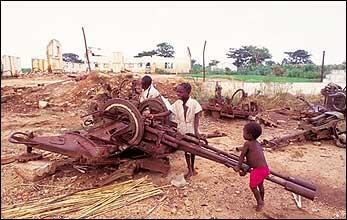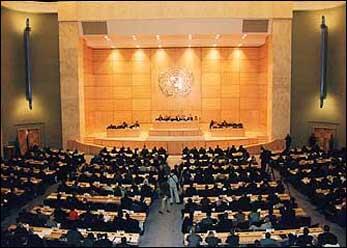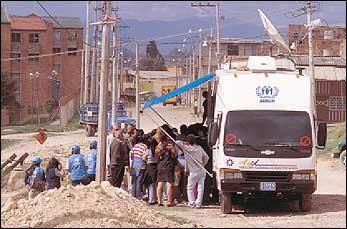The Year in Review: Good News, Bad News
The Year in Review: Good News, Bad News

Return reality: over 2 million Afghans went home, another 4 million remain abroad.
GENEVA, Dec. 26 (UNHCR) - They returned by foot or occasionally on horseback. They came jammed in pickups, on motor scooters and buses. Groups of families surrounded by donkeys, suitcases, satellite dishes and huge wooden beams from their old homes, perched precariously atop convoys of trucks resembling overcrowded fairground gondolas swathed in a kaleidoscope of colours.
Following 23 years of war and the worst drought in living memory, travellers were often greeted on their return with scenes drawn from Dante's Inferno. "Look at my hair. It went white when I saw it," one grizzled old farmer said as he returned to his village for the first time in a decade. "How to live in this place? How to feed my family?"
But despite the hiccups, the hazards, the physical hardships and the massive destruction all around, humanitarian officials recall that this sprawling and often seemingly disjointed operation had in the end been relatively orderly, efficient and 'amazingly successful.'
After all, more than two million people poured back into one of the most desolate and dangerous places on earth during the year - twice as many as had been anticipated.
This return to Afghanistan, in fact, was the largest repatriation of refugees for three decades, ever since 10 million people had fled from the disintegrating region of East Pakistan into India in the early 1970s and then returned to the newly created state of Bangladesh.
Developments in central Asia undoubtedly dominated the headlines, but there were other significant developments - both good and bad - during a year High Commissioner Ruud Lubbers described as a 'mixed bag.'
The number of persons cared for by UNHCR had dropped by nearly 2 million the previous year, to just under 20 million. Those figures kept falling in 2002, fuelled mainly by the Afghan returns, and Lubbers predicted that this trend would likely continue. Only eight years earlier the refugee agency had been assisting more than 27 million people around the world.
And while the drop in the overall number of people needing help was encouraging in itself, equally positive was that much of this progress was reported from some of the world's worst trouble spots - situations described in official parlance as 'protracted situations.'
Hundreds of thousands of people were killed during a quarter century of war in Angola and more than 4 million were displaced, but the guns fell silent there following yet another peace agreement between the government and guerrillas of the UNITA rebel movement.

Angolan children play among the wreckage of war. But there are hopeful signs in another of the world's longest running conflicts.
Sierra Leone's population still bears the scars - literally - of its own horrific decade-long war. Tens of thousands of civilians were mutilated by rebels, many of them boy and girl soldiers, but as that West African state came slowly out of its nightmare, more than 200,000 people returned to the country. One young voter at an election who had had his arms chopped off, summed up both the brutality of the past and the hope for the future with a memorable quote: "I used to vote with my hands. I did it today with my toe."
Sri Lanka was once described as the Pearl of the Indian Ocean but during two decades of equally relentless civil war in which an estimated 65,000 persons perished, it adopted a more sombre name, the Teardrop of Buddha. Warring factions there also called a halt to the carnage in 2002 through a Norwegian-brokered truce, and the first of nearly one million uprooted persons began returning home.
East Timor achieved full independence. A quarter of a million people went back and domestic conditions improved sufficiently for UNHCR to invoke the cessation clause of the 1951 Refugee Convention, a little-known mechanism under which the agency acknowledged that the great majority of uprooted nationals no longer needed refugee status and should go back to their villages and towns. The clause was similarly invoked for Eritrean refugees living in Sudan. Both directives took effect at the end of 2002.
In the Balkans, after more than a decade of major involvement, the agency continued a phase-down of its operations. It could be largely out of the region in the near future as Lubbers said the emphasis shifted from refugee operations to longer-term reintegration and reconstruction. More than 2.2 million civilians had returned home in the last few years. Paddy Ashdown, the current High Representative in Bosnia and Herzegovina, described the U.N. role there as "one of the unsung success stories of the post cold war era."
Vigorous protection
In the most important global meeting on refugees in a half century held in Geneva in late 2001, some 127 countries adopted a landmark declaration reaffirming the validity of the 1951 Refugee Convention.
Building on that endorsement, the refugee agency shaped what it called an Agenda for Protection to serve as a guide for governments and humanitarian organizations in their efforts to strengthen the help afforded to refugees.
High Commissioner Lubbers said three major concerns had repeated themselves throughout the year - the need for better protection in the new migratory context; a more vigorous search for permanent solutions for the world's uprooted peoples; and a more equitable system of 'burden-sharing' between donors, countries of asylum, those poorer states which hosted the bulk of the displaced and the embattled regions from which refugees fled in the first place.
While underscoring the continued centrality of the 1951 Geneva document, and in a direct follow-up of the Agenda, Lubbers launched what he called a 'Convention Plus' approach to strengthen the treaty in those three areas, and particularly tried to position the refugee agency to be more involved in the search for solutions. "2002 was the year UNHCR became part of the solution," he said.
UNHCR's first ever statistical yearbook, released at the end of 2002, provided an insight into global forced displacement over the past decade and the data gathered could influence future humanitarian debate.
It noted, for instance, that while developing countries produced 86 percent of the world's refugees during the period, poor nations also afforded 72 percent of them sanctuary, numbers which underscore "the responsibility of industrialized states to share in international refugee protection."
Excluding these same industrialized countries, 10.7 million refugees arrived between 1992-2001 and in the same period 14.1 million refugees went home.

An unprecedented meeting of states and organizations in Geneva set the stage for the adoption of an Agenda for Protection for refugees.
Setbacks and disappointments
To be sure, there were setbacks and disappointments in 2002. Parts of Africa continued to burn as long-time conflicts remained unresolved.
The war in Liberia showed no signs of ending. Neighbouring Côte d'Ivoire, once the most stable of regional countries, plunged into its own civil conflict, threatening to destabilize Africa's entire western seaboard.
Despite almost around-the-clock regional and international peace efforts, large swathes of central Africa including the Congo basin and Burundi teetered between renewed hopes for peace and more anarchy. Tanzania, one of the world's poorest nations, hosted one of the world's largest concentrations of refugees, a staggering 1 million people, some who have been in exile for several decades.
In the Horn of Africa, some 25,000 Somali refugees left their Ethiopian exile, and Eritrean refugees continued a slow repatriation from Sudan. But hundreds of thousands of Sudan's own population were blocked from their homes as tortuous peace talks between Khartoum and rebels continued. Ragtag groups of armed men and women terrorized refugee camps and other communities in northern Uganda from sanctuaries in southern Sudan.
In the far north-west of the continent, 150,000 refugees from the former Spanish territory of Western Sahara squatted in their tents and huts, feeling forgotten and abandoned by the outside world and often used as pawns by the regional powers.
"In Africa we are at a crossroads, betwixt and between," said David Lambo, head of UNHCR's Africa bureau. But if the present and the future remained uncertain, he believed a wider context was necessary to judge Africa's progress. "After all, at the start of the 90s, there were more than 6 million refugees on the continent," the Nigerian-born official said. "Now there are around 3.3 million. That is still far too many, but we should not underestimate these individual victories."
In Colombia, the worst humanitarian situation in the Western Hemisphere continued to deteriorate. Since 1985, as many as 2 million persons were forced from their homes and around 200,000 fled in the last year alone.
Across the world, the fate of 269,000 refugees from Azerbaijan or 110,800 refugees from the mountain-top state of Bhutan were as far from resolution as ever, while the ongoing bloody conflict in Chechnya was highlighted in horrific fashion by the storming of a theatre in central Moscow and the subsequent deaths of dozens of civilians and their Chechen captors when special forces stormed the arena.
Around 1 million people remained displaced in the Balkans, principally ethnic Serbs from Croatia and Kosovo currently living in the rump Yugoslav Republic of Serbia and Montenegro. Despite strenuous efforts to encourage nearly one quarter of a million Serbs to return to Kosovo, few had braved the journey back.
An estimated 25 million people - twice the number of refugees - were forced from their homes within their own countries. Though these so-called internally displaced persons (IDPs) do not fall directly under UNHCR's mandate, the agency nevertheless helps an estimated 5.3 million of them. The rest live without international aid or recognition, often the victims of deliberate discriminatory policies by their own governments.

As the situation in Colombia deteriorated, as many as 200,000 people fled during the year and UNHCR employed mobile registration vehicles to help people obtain ID cards.
September 11
And casting a shadow over everything was the ongoing fallout from the September 11 terrorist attacks. In the immediate aftermath, as countries around the world raced to strengthen their legal and physical defences, there were grave concerns that legitimate refugees and asylum seekers would be swept away in the rush to the barriers.
In the event, the fallout was not as severe as initially feared. According to Lubbers, "Governments in general refrained from over-reacting to the situation" but he added the proviso, "That is not to say there have not been some serious downsides."
During the subsequent fighting in Afghanistan an unknown number of civilians were killed and hundreds of thousands of persons fled their homes.
In the name of security, measures were introduced in some countries which led to the exclusion of genuine asylum seekers or even their forcible removal, an increased number of extradition requests and the introduction of overly restrictive legislation.
Australia's so-called Pacific solution and detention policies towards asylum seekers caused continuing concerns among many humanitarian groups, though Canberra vigorously defended its approach as appropriate and measured.
The permanent resettlement of refugees to the United States, the world's largest recipient of needy cases, was particularly hard hit. Washington admitted only 27,100 people compared with a target of around 70,000, the lowest number in a quarter century.
Spillover
Europe's long-time efforts to harmonize its immigration and asylum policies were buffeted by the chill effects of 9/11, national elections, and media and public debate which sometimes spilled over into xenophobia and sometimes failed to differentiate - perhaps deliberately - between refugees, asylum seekers and the larger issue of economic migration.
The United Kingdom, Denmark, the Netherlands, Italy, France, Belgium and Germany all announced or introduced asylum or immigration legislation, often aimed at reducing both the numbers of and benefits for applicants.
This appeared to have the desired effect in at least some cases. During the first few months of 2002, the number of asylum seekers in 'hard-line' Denmark, the Netherlands and Belgium plummeted dramatically.
In contrast, the figures in Norway, Sweden and Finland spiralled upwards, some commentators suggesting asylum seekers had switched their attention to these countries away from their 'get tough' neighbours.
In Britain, which registered the highest number of asylum claimants in 2001 with 92,000, the furore was particularly loud though Prime Minister Tony Blair insisted "We are not advocating a 'Fortress Europe.' But there has to be some order and some rules brought into the system ... "
In southern Europe, Spain announced new visa controls, Greece signed a readmission agreement with Turkey and Italy introduced a new immigration and asylum law which UNHCR worried offered insufficient safeguards for people seeking sanctuary.
Greece reported several dozen persons, including small children, had perished in the first months of 2002 in their attempts to gatecrash the continent. Off Italy in March, a vessel carrying some 65 Kurds sank in rough seas and a few days later the navy intercepted one boat with 22 people aboard and the bodies of six others hooked to the sides of the ship.
Such headline stories often obscured the good news. Germany through legislation and France through a shift of policy, came into line with most other European countries on the issue of whether a person could be recognized as a refugee if they were fleeing persecution by so-called 'non-state agents' such as rebel movements. These European governments previously had insisted refugee status could be granted only in the case of persecution by 'recognized' states.
In Austria, a young woman from the African state of Cameroon was granted refugee status on the grounds she feared circumcision in her homeland, the first time in Austrian history a person had been approved on the grounds of gender-based persecution. Two months later, a 14-month-old baby girl from Ethiopia received permission to stay on similar grounds.
The future
Even if results in Afghanistan in 2002 were 'staggering,' High Commissioner Lubbers cautioned that "huge tasks still lie ahead."
Around 4 million Afghans remained abroad. With an anticipated budget of around $200 million for 2003, UNHCR expects to help an additional 1.5 million return in the next 12 months.
But like the early arrivals they will come back to a country still on its knees, where reconstruction has been modest, warlords reign supreme in some regions, where health care is among the worst in the world and where there is the beginning of a backlash against one of the most promising developments since the fall of the Taliban, the education of girls.
Some Afghans fear the task of rebuilding the country is so enormous the international community could eventually just walk away, as it did once before, though Lubbers doubts that.
If Afghanistan's future was fragile, progress in the other two major 'breakthrough areas' - Sri Lanka and Angola - appeared sturdier, with some of the major causes of conflict resolved. Hundreds of thousands of civilians were expected to continue the long march home begun in those countries in 2002.
But parts of Africa such as Liberia, Western Sahara and Burundi remain deeply troubled. Looking beyond immediate refugee crises, UNHCR's Lambo insisted there had to be fundamental improvements in the way millions of Africans were treated by the rest of the world. This included how they were compensated for their products such as cocoa or coffee crops, before the root causes of displacement could be successfully tackled. "The current global economic structure is simply crazy," he said, "an insult and an enemy of many Africans."
UNHCR also planned a comprehensive study in the coming year on alternatives to detention for asylum seekers.
And there was THE big unknown, whether there would be a conflict in Iraq which would most likely trigger a fresh exodus of civilians in the region.
If 2002 was a 'mixed bag', 2003 promises to be more of the same.









